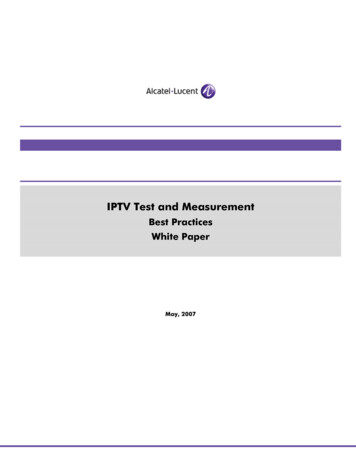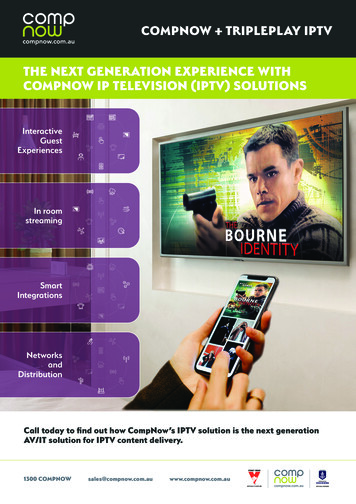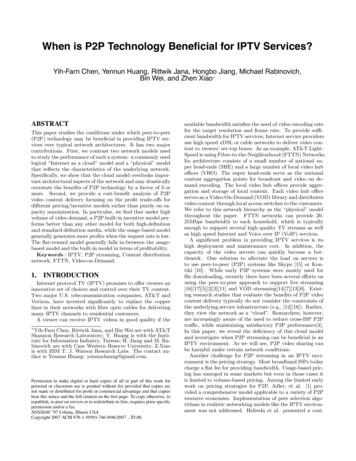
Transcription
IPTV Test and MeasurementBest PracticesWhite PaperMay, 2007
OverviewScope:The use of Test and Measurement (T&M) in IPTV service rollouts can be divided into two broadcategories: Service Assurance and Performance Analysis. Performance Analysis is concerned withanalyzing a pre-operational IPTV setup in the lab or in the field. Service Assurance on the otherhand is primarily concerned with assuring IPTV service quality in a live operational environment.This paper focuses on providing a pragmatic set of test and measurement guidelines that can beimplemented on a live operational IPTV service for the purposes of service assurance. Theaudience is engineers, operations, and operations managers concerned with providing quality IPTVexperience over a controlled IP Network. While, the recommendations here are generallyapplicable to any IPTV system, specific middleware implementations have unique requirements.Recognizing this, this paper is focused on Microsoft’s IPTV Edition software platform. (MSTV)Reader familiarity with Alcatel-Lucent’s triple play service delivery and Microsoft TV servicearchitectures is assumed.Goal:The goal of this paper is to provide a recommendation for the three important operationsengineering decisions for service assurance:Definition of the generic demarcations where measurements should be made in a live IPTV networkRecommendations on measurement methodologiesRecommendations of a minimum set of measurements to gain visibility and troubleshoot IPTV &Microsoft TV quality issues.These recommendations have been developed, tested, and calibrated with the industry leadingvendors of test and measurement equipment. The goal of the recommendations was to ‘keepthings simple’ and do not represent an academic optimization, but rather represent pragmatism.Fully instrumenting every possible place in the network is likely to be prohibitively expensive—onthe other hand not instrumenting anywhere in the network will not lead to a good customerexperience. This paper does not attempt to build a business case around where to put probes andhow many probes to put into the network because that is highly dependent on individual operatorarchitecture trade-offs—the recommendations here can be used as engineering guidelines formaking those operator-specific business decisions.Methodology:To accomplish these goals, Alcatel-Lucent setup an IPTV service assurance calibration environmentand formed a working group of industry leaders in the IPTV T&M space. The invited T&M vendorsincluded Agilent, IneoQuest, JDSU, and Spirent Communications. Over a period of 6 months, theworking group architected the demarcations, measurement methodology, and defined the minimalmeasurements needed. The group then calibrated available service assurance equipment in aMicrosoft TV environment. This paper presents those results.Key Findings:IPTV service assurance requires pulling data from a combination of test and measurement probesand network/service devices. The network/service devices to pull data from and limitations areenumerated in the document.The key measurement demarcations for probes are: 05 2007 Alcatel-Lucent. All rights reserved.i
SHO/Headend (Multicast UDP from the encoder),Transport Network (core network validation of the MPLS traffic),Last Mile (Central Office monitoring or remote location),xDSL ( DSL validation),House (Internal home wiring and residential gateway testing)For reasonable installations of probes, there is a strong recommendation for probes to be installedon port mirroring or monitoring ports on routers, switches, and Access Gear (i.e. DSLAMs). Thereare a choice of configurations and tradeoff’s to be made.There are key measurements that should be made at each point which are listed in the document.Due to added quality optimizations in Microsoft TV, generic standard measurements do not alwaysproduce an accurate reflection of video quality. 05 2007 Alcatel-Lucent. All rights reserved.ii
ContentsIPTV Architecture and Demarcations:.1Measurements and methodology: .3What to get from the network and how: .3Measurements with Probes .7Calibration activities and results. 9Agilent Technology Results .11IneoQuest Results .12JDSU Results. 12Spirent Communications Results .13Application of MDI (Media Delivery Index) to Microsoft TV IPTV Edition.14Acknowledgements: .15Appendix A: Microsoft TV ALERT NOTIFICATION ARCHITECTURE (DIRECT ACCESSMETHOD) .17Appendix B: Table of Measurements, Methodology, and Calibration Attempt .18IPTV Architecture and Demarcations:This section provides a generic IPTV/ Microsoft TV architecture and set of service assurancedemarcations. While individual IPTV service architectures may vary in the details, the basic formuladescribed here holds.For this discussion, we are focused on service assurance of the IP network components of IPTV. It isassumed that video feeds are clean from the source, assured by using typical video T&Mequipment.There are 4 major locations that need to be monitored for IPTV service delivery. A typicalimplementation of Microsoft TV on the Alcatel-Lucent triple play service delivery architecture isshown below:Figure 1: Microsoft TV over TPSDA Architecture 05 2007 Alcatel-Lucent. All rights reserved.1
Generally demarcation points in each of the four areas must be defined considering the differentgroups and units within a service provider’s organization that will handle issues based on wherethey are found:First Network Monitoring point – The“Head-End”The first monitoring location is between the traditional cable head-end, and the network interface.This would typically be the interconnection between the MPEG2/H.264 encoders, and the videosoftware platform (in this case Microsoft IPTV Edition) ingestion point, the A-servers. This can befound in the SHO and VHO of the diagram above.Figure 2 Typical Architecture of First Monitoring PointSecond monitoring point – “Transport”The second monitoring point is network transport monitoring. This would typically be monitoring atthe VHO/Regional center egress from the transport network and represents issues that can occur inthe transport of video from the SHO to the VHO.Third Monitoring Point – “Last Mile”The third monitoring point is the VDSL or FTTH line. Some T&M can be done at the egress fromthe VHO or at a remote DSL cabinet with the use of a permant or longer term leave behind testdevice. In addition to IPTV measurements with a measurement probe in the DSLAM qualification ofthe copper lines can be completed without having a technician “onsite”. These type of a devicescan have drawbacks due to CAPEX cost and space availability at each DSLAM. Ultimately fieldmonitoring may need to be done at the customer premises, but would require a “truck roll” servicecall for the installation of a handheld or other device. (i.e. the termination point for the VDSL orFTTH) causing OPEX cost. Note this is single user monitoring. 05 2007 Alcatel-Lucent. All rights reserved.2
Figure 3: “Last mile” architectureFourth Demark – “In House Network (Home wiring)”The last demark being the actual Set-Top-Box, residing behind the Residential Gateway, andconnected through a variety of LAN technologies (Ethernet, MOCA, HPNA, etc.).Measurements and methodology:Broadly, measurements at the various monitoring points can be taken either from equipment in thenetwork already or by placing probes at key points in the network. The recommendedmeasurements appear in Appendix B. What follows is a discussion of how to get themeasurements with either probes or from the network itself:What to get from the network and how:Figure 4 provides an iconic overview of the key element management systems from which data canbe collected in the Microsoft TV network. These are as follows:1. Middleware Servers (Microsoft TV application generated parameters collected directly fromthe A/D servers)2. Middleware EMS (Microsoft MOM/SOM)3. Access Equipment EMS (Alcatel-Lucent’s AMS 5526)4. Service Quality Calculation Software (Alcatel-Lucent’s SQM 8920)5. Network Equipment EMS (Alcatel-Lucent’s SAM 5620)6. Test and measurement probesSince items 1-5 are placed in the network for management purposes, the tendency is to investigatetheir applicability before instrumenting the network with probes as suggested by 6. This section willcover the use of non-probe solutions—probes are covered later. 05 2007 Alcatel-Lucent. All rights reserved.3
Data Mgmt & Correlation EngineT&MMS MOM552689205620PROBES7x50sA/D Figure 4 Data collection points in the Alcatel-Lucent Microsoft TV networkThe following is a brief description of each of these systems.Microsoft TV application parameters collected directly from the A/D servers – Here, theparameters are collected directly from the log files generated on the A or D server by the perfmonutility of Windows. For the A servers, 24 per-channel parameters and 8 aggregate parameters are-generated. For the D servers, 33 per-channel parameters and 24 aggregate parameters aregenerated. Tools can be easily developed to extract these parameters and send northboundnotifications to a data/fault management engine. (see tables below for the performance impactdata on the integration of real time alerts with a data correlation engine).Appendix A provides the architecture for a northbound integration system to dynamically set triggerpoints on specific parameters and receive customized notifications.The following tables show the impact on the CPU (2.6 GHz, 3.8 GB) when near real-time directdata collection and notification tools are running on the Microsoft TV server. Note, for thismethod, the load on the hard disk from logging every available parameter every second (i.e., atable entry with 150 columns, every second) is only about 22 MB per day (or 8 GB per year). 05 2007 Alcatel-Lucent. All rights reserved.4
# paramsmonitored& alertsgeneratedpolling/notificationinterval(secs)% memincrease% CPUincrease325 secs0.5%1%323 secs0.5%762 secs1281 sec# paramsmonitored& alertsgeneratedpolling/notificationinterval(secs)% memincrease% CPUincrease575 secs0.5%1%1%573 secs0.5%1%0.5%1.5%902 secs1%2%1%2%1221 sec1%2%Table 1 A Server performance impact for theTable 2 D Server performance impact for theDirect Collection MethodDirect Collection MethodMicrosoft SOM – The Microsoft Server Operations and Management (SOM) is a system of tools(this includes the Microsoft Operations Manager (MOM)) designed for a large scale Microsoft TVnetwork. It consists of the following sub-systems for data gathering and collection:Systems Management Server – This can manage up to 20,000 client (A/D server) inventories.Microsoft Operations Manager - This can collect parameters from up to 3000 A/D servers. Thebasic MOM architecture is similar to the direct data collection approach mentioned above in termsof requiring installation and configuration of the MOM agent on every A/D server (similar to a toolcollecting data from the log file on every server). The scaling advantage afforded by MOM is tothe northbound element. As it allows the manager to be a first level filter, potentially reducing totalnorthbound alerts.The SOM also has other tools that provides automated deployment services and data protection aswell as a software library server enabling expedited application development (allows up to 600simultaneous accesses)Access EMS: (Alcatel-Lucent AMS 5526) – This system is ideal for monitoring QoS parametersfrom the DSLAM to the Residential Gateway. It allows monitoring of traffic and diagnostic datawith user-defined alarm views. 100% of local functionality can be accessed remotely (TBD whendocs are available).Service Quality Calculation Software: (Alcatel-Lucent SQM 8920) – This is acomprehensive tool that takes measurements from the network and processes them, producing ametric indicating the picture quality perceived by end-users. It uses a combination of A and Dserver, STB, and probe based measurements gathered by the methods mentioned in this sectionand also incorporating data available from probes such as real-time MPEG TS analysis andmonitor video source and encoding quality. (note that it is also an audience measurement andinventory management tool).Network Equipment EMS: (Alcatel-Lucent SAM 5620) – This system manages the 7750Service Router and the 7450 ESS. Router specific SNMP traps for thresholds (rising and fallingedges) can be set to generate specific fault and alarm specifications (TBD when docs areavailable).The following table summarizes the advantages and limitations of the above system and clarifiessome of the overlapping functionality of three of the above systems. A need for a strong fault 05 2007 Alcatel-Lucent. All rights reserved.5
diagnosis engine could necessitate the simultaneous deployment of most of the systems mentionedbelow.Note, the sole deployment of the direct access method in lieu of some of the systems is notrecommended, but it can mitigate the limitations of the other systems to allow for a highly effectivefault management and correlation engine.SYSTEMADVANTAGESLIMITATIONS1. Middlewarefull range of IPTV application parameters anotServerswide range of system parameters, such as CPU,deployment(Microsoft TVmemory utilization and debug parametersapplication(queue counts) which can enable a predictivegeneratedalert before the actual fault arises in the systemparameterscollected directlyfrom the A andD opment effort (though notlarge, from our experience)good for small-size deployment as it eliminatesthe installation, configuration, and maintenanceoverhead of more complex systems and doesaway with a single point of failureminimal performance impact on the MicrosoftTV servers, even at near real-time notifications2. MiddlewareEMS – (MicrosoftMOM/SOM)well suited for large scale IPTV deploymentcompatible with SOM inventory managementand deployment tools.can be configured to act as a first level filter tonorthbound elementsonlyasubsetofserverparameters can be monitored,more difficult to develop faultpredictionsalgorithmsifdeployed without other systems.can be a single point of failure ifdeployed without other systems3. Accessallows for hierarchical monitoring views frommonitors only a subset of the IPTVEquipment EMSsystem to node levelnetwork elements.allows for user defined alarm viewsnot easily scalable to large IPTV(Alcatel-Lucent’sAMS 5526)optimal for ADSL in small to medium-sizednetworksnetworks4. ServiceQualityCalculationscalable to large scale IPTV networksintegrated product which can monitor A/Dservers and STBs, do audience measurement, 05 2007 Alcatel-Lucent. All rights reserved.smallestsubsetofserverparameters monitored, difficult todevelopfaultpredictions6
Software(Alcatel-Lucent’sSQM 8920)and manage inventorycan be configured to act as a first level filter tonorthbound elementsalgorithmsifdeployedinisolationcan be a single point of failure ifdeployed without other systems.5. Networklarge number of alerts possible with granularapplicationEquipment EMSthreshold setting capabilitymay not be reflected accurately in(Alcatel-Lucent’sSAM 5620)very scalable, and can be configured to act asa first level filter to northbound elementslevelimpairmentsthis systemdata access requires significantconfigurationeffort,multipletypes of access required to obtainall the data6. Test andmeasurementFull set of detailed measurementsNo impact on service deliveryHighercostmeanstargeteddeployment is prudentprobes/handheldTable 3 Analysis summary of data collection systemsMeasurements with ProbesAs specified in the previous section, there are some cases where due to accuracy concerns orscalability concerns an operator should put equipment in the network specific to service assurance.While taking measurements directly in-line at a demarcation may seem to be the moststraightforward method of inserting these probes it is not recommended in an operationalenvironment. Inserting anything more than absolutely necessary in the actual service streamprovides a higher potential to negatively impact service and should be avoided—particularly wheremultiple customers can be impacted. There are five recommended ways to insert T&M probes:Option One: In-line equivalent passive monitoringPassive monitoring is the safest method for adding a probe because the probe cannot impactservice. If a probe is required to be in-line then an in-line equivalent can be setup using two mirrorports on a router as shown in the figure below. 05 2007 Alcatel-Lucent. All rights reserved.7
Advantages:Provides an equivalent setup to in-line, butassures passive behavior meaning the probewill never impact the service.Disadvantages:Requires two ports on a router/switch.Depending on the router/switch mirror portscan be service impacting. (note this is not thecase with Alcatel-Lucent’s 7750 and 7450hardware).Figure 5: Passive monitoring, in-line equivalentThe ingress and egress to the router/switch are configured to be mirrored to two separate ports onthe probe. This allows for the continuation of Full-Duplex on the lines. Mirror ports, if implementedcorrectly in router or switch hardware can provide a complete equivalent of in-line monitoringwhile not creating a potential for negative service impact from T&M equipment.Option Two: Passive Monitoring, Potentially Measurement ImpactingThe second option is to mirror both ingress and egress of a line under test to a single mirror port,likely on two different VLANs using distinct VLAN IDs.Advantages:Provides all line data as if in-line, and assurespassive behavior meaning the probe will neverimpact the service. Requires only one mirrorport.Disadvantages:Because you are mirroring a full duplex lineonto a single direction of a mirror port line,there is a potential for congestion on the mirrorport that could impact surement impactFrom a probe perspective, this doesn’t look exactly like an in-line setup so the probe must supportthis configuration (i.e. support measurement VLAN’s) or the measurement of concern must not bedirectional in nature (for example, getting a “program ID” wouldn’t matter).Option Three: Active, but no unicast monitoringSometimes passive monitoring is not possible. For example if you would like to test the response ofa D-Server to a channel change request you would need to join the service. Any multicast can bejoined to provide semi-passive monitoring of multicast streams. In this case you can setup a probeto be a part of the service (e.g. in the VPLS domain of the service similar to how an end-user wouldbe attached if directly Ethernet connected). 05 2007 Alcatel-Lucent. All rights reserved.8
Advantages:Requires only one port for monitoring. Canjoin/receive the service and provide an “enduser” view. Can support active testing.Disadvantages:Potentially service impacting. Cannot passivelymonitor unicast traffic on the network.Figure 7: Active monitoring, no unicastOption Five: Access Probe In-lineThere are two special cases where in-line devices may be appropriate to use, both of them applyfor single users (i.e. in the home or on an access line). These are ‘Option Five: Access Probe InLine’ and ‘Option Six: In-home Ethernet’.Option five entails placing a handheld or other device on a DSL or other access line. This isgenerally a temporary installation by a field technician at the end of an access line fortroubleshooting purposes. The use of an in-line device at times is not considered a best practicemeasurement technique due to the fact that it introduces another point of failure in the solution. “Ifthe device fails, then perhaps the network traffic fails to pass through.”Option Six: In-homeDepending on device costs and level of service issues an option is to leave a device in the home formonitoring of in-home networking and service.Calibration activities and resultsA major activity with regards to this IPTV Edition test and measure document was to understand thecurrent landscape of the various network probe manufacturing companies. Four of the industryleading vendors were given the opportunity to take part in a calibration activity in the AlcatelLucent Proof of Concept lab for this document. These four vendors were Agilent Technologies,IneoQuest, JDSU, and Spirent Communications.As part of the eco-partnership that was formed all the parties met and created a list of essentialmeasurements that can be used for IPTV Edition. (Appendix B) Some of these measurements arealso used during the calibration exercises.Each of these companies was then asked to bring their latest test and measurement platforms forIPTV Edition and calibrate against each other and the measurements agreed upon. The testing wasbased on the injection of artificial impairments as outlined in the “Impairment” section.Five points were selected as major measurement locations in the Alcatel-Lucent IPTV Editionarchitecture. Each of these points allowed for the maximum flexibility in monitoring the solutionwithout integrating a large number of probes into the network. More probes can be added at theother points listed in appendix C if more detailed monitoring is required for a specific service.The following points were listed as major measure points: (see Appendix C) 05 2007 Alcatel-Lucent. All rights reserved.9
SHO/Headend: for Multicast UDP from the encoder (Point A).Transport Network: for core network validation of the MPLS traffic (Point E)Last Mile: for Central Office monitoring or remote location. (Point O)xDSL: for DSL validation (Point J or K)House: for internal home wiring and residential gateway testing. (Point L)The two most common methods that were used to measure the statistics of the IPTV Edition streamswere active and mirror ports by the four vendors. Each vendor was able to select the method thatthey wished to use for the calibration activities. There was one exception with the test case using theIneoQuest Geminus being used to drop packets. For this testing the vendors were required to usemirror ports that were enabled at the locations located above.Impairment MethodologyIn order to calibrate the four vendors against the list of selected measurement types displayed inappendix B, artificial IP based impairments were injected to the streams. Two devices were used todo this, a Spirent Converged Network Impairment Emulator “CoNIE” and an IneoQuest Geminuswith a G1 module. Both of these devices were used physically in-line to the IP streams at severallocations in the PoC lab environment.With a traditional IPTV service only one impairment location maybe needed to test the impacts of acorrupted stream. But with the R-UDP methods that Microsoft deploys with its IPTV Edition it wasdecided that three locations were needed to test the impacts of a corrupt stream. The locationsselected were as follows:Point A (Multicast UDP stream, Pre A-server)Point E (Multicast RTP in the network core, Post A-Server and Pre D-Server)Point O (Multicast RTP in the Last Mile before the 7330, post D-Server)See Appendix C for location reference.At each point the tests were conducted against both a High and Standard Definition stream. Thestreams consisted of H.264 encoding in a MPEG2 transport stream.The Spirent CoNIE allowed for complete impairment of the IP stream. It utilizes the ITU-T G.1050network impairment model. For the impairment test cases only two were used, 132c and 132f.The 132c test case represented a medium level of impairment for the IPTV Edition system. Themedium level was to simulate occasional quality issues on the STB and TV located in the residence.High impairments of test case 132f cause sever quality issues on the STB. Both cases for the CoNIEwas run at each of the three demarc locations for impairments.The IneoQuest Geminus was used at points A and O and allows for a very detailed simulation ofpacket loss. An individual video stream can be selected using the IQMediaAnalyerII software.During testing in the PoC lab a loss of 16 per 1000 packets were issued on the streams. Theprecise nature of these test allowed for a more detail analysis of the MDI measurements.Measurement ResultsThe following charts will outline the measurement results from each vendor. These tables haverecorded all the measurements that the vendors were able to take along with the calibration resultsfrom the agreed upon metrics.The chart has been laid out in the following manner.Line items in Red are “Calibration” metrics. These are the agreed upon measurement to validatethe same value from all the vendors.Line items in Green are “Non-Calibration” metrics. Measurements that were also deemedimportant but not calibrations are also outlined. We did not attempt to agree on exact formulas or 05 2007 Alcatel-Lucent. All rights reserved.10
values for the metric allowing for variation in the specific measurement result meaning that while itwas agreed to be an important metric,.Line items in Grey are measurement that can not be taken at a given demarc or are of noimportance in monitoring the IPTV Edition solution.Actual measurement scores from each of the vendors have not been included in this documentbecause the actual value was not an important result for an engineer designing an Microsoft TVT&M solution. Instead each vendor received the following scores,Completed – Measurements were taken in at a calibration point, but no other vendor completed aresult at this point. Therefore no calibration could take place.Measured – A result was recorded for a “non-calibration” measurement.Calibrated - Two or more vendors matched to receive a calibrated score.Completed N/C – A score of Not Calibrated is a measurement that was taken at a “calibrationpoint” but it did not resemble another vendor’s score.A Blank entry in the table means that no information was provided by the vendor for that measureor demarc point.A result of Completed Not Calibrated means that the measurement was taken but did not matchwith in the 2.5% margin of error between vendors.* Note: Program Name was not available during the time of testing. It has been included in thisdocument as it is considered an important measurement.Agilent Technology ResultsAgilent Technologies used their J6900A Triple Play Analyzer in conjunction with the DistributedNetwork Analyzer (DNA) and DNA PRO product line. Triple Play Analyzer testing occurred on theDNA Hardware probe as well as “off the self” NIC cards. The DNA’s and NICS were attached viamirror ports, aka “passive testing” for all the information provided. 05 2007 Alcatel-Lucent. All rights reserved.11
IneoQuest ResultsIneoQuest applied three methods of network monitoring with their Geminus G1, G10, SingulusG1-T, and Singulus Lite “Cricket”. The Geminus access was implemented using both active andpassive ports to monitor the video streams in the IPTV Edition solution. The Cricket was used in-linebetween the residential gateway and the set top box and also standalone in set top box emulationmode. These devices were controlled using the IQMediaAnalyzer and the IP Video ManagementSystem products.JDSU ResultsThe JDSU Qt-600 was used on the passive mirror ports to monitor the IPTV Edition traffic in theSHO, Core network, and VHO demarcs. For the home demarc the HST-3000 was used. It allowedfor both DSL and Ethernet monitoring of the video streams. 05 2007 Alcatel-Lucent. All rights reserved.12
* "Due to time constraints, JDSU declined to calibrate at point J. Based on the measurement at point K It was judged that JDSU could havemade the measurements at point J using their handheld probe in a continuous monitoring mode, justifying the 'measured' designation."Spirent Communications ResultsSpirent’s used several of their network appliances for this activity in the Alcatel-Lucent PoC lab. TheVideo Test System (VTS) along with the SmartSight Triplay Solution using SmartSight Central andIPMax were all used in both active and passive testing of the IPTV Edition streams. 05 2007 Alcatel-Lucent. All rights reserved.13
Application of MDI (Media Delivery Index) to MicrosoftTV IPTV EditionAs a result of testing during these exercises for IPTV Edition platform some conclusions wereformed around the use of the Media Delivery Index.The Media Delivery Index (MDI) is described in RFC 4445 as being a “measurement that can beused as a diagnostic tool or a quality indicator for monitoring a network intended to deliverapplications such as streaming media, MPEG video, Voice over IP, or other information sensitive toarrival time and packet loss.” The MDI measurement is made up of 2 separate measurementstypically displayed separated by a colon. They are Delay Factor (DF) and a Media Loss Rate (MLR).The IPTV Edition has some very unique tool
making those operator-specific business decisions. Methodology: To accomplish these goals, Alcatel-Lucent setup an IPTV service assurance calibration environment and formed a working group of industry leaders in the IPTV T&M space. The invited T&M vendors included Agilent, IneoQuest, JDSU, and Spirent Communications. Over a period of 6 months, the










